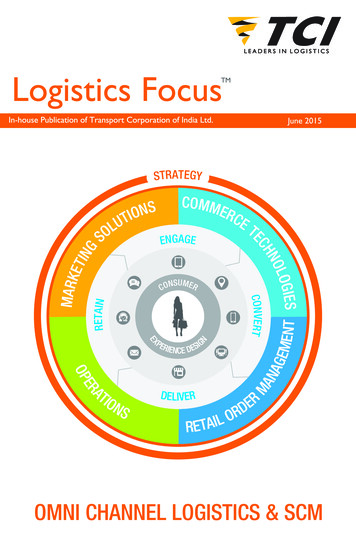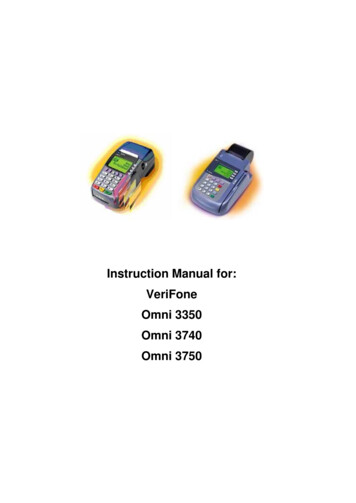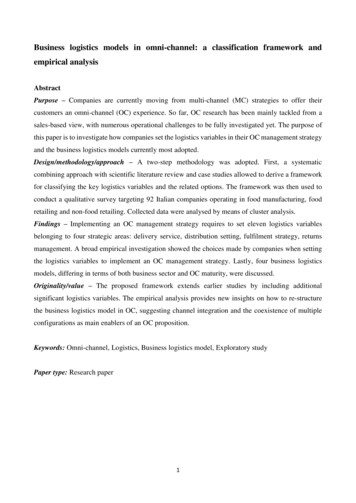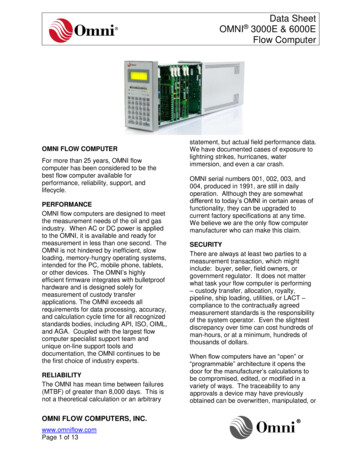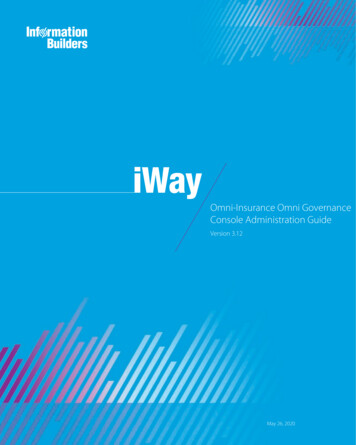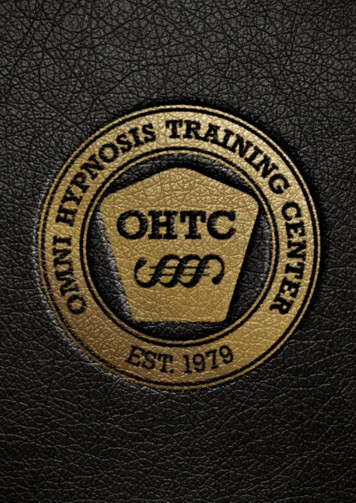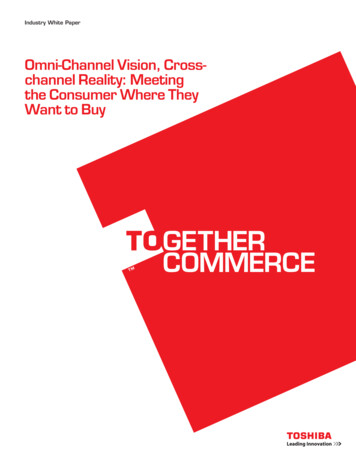
Transcription
Industry White PaperOmni-Channel Vision, Crosschannel Reality: Meetingthe Consumer Where TheyWant to Buy
Omni-Channel Vision, Cross-channel Reality: Meeting the Consumer Where They Want to BuyKey TakeawaysThe station’s schedule flashes: ICHON TRAIN ARRIVING. Cross-channel brand interaction has become a must-havecapability for retailers, not just a luxury Cross-channel is primarily about enabling consumer interactionand participation in the shopping experience—supportingtechnology is secondary Cross-channel shopping is good for stores Retailers have already begun building their own cross-channelfutures Retailers will take unique technological paths as cross-channelreality eventually meets their omni-channel visionThe application prompts him, Pay Now or Pay At Pick-Up.Young-Jae starts walking toward the train doors, takes a seat,and clicks, Pay At Pick-Up.As the train doors close, Young-Jae’s mobile phone buzzes. It’s atext message with links to pick up instructions and a QR code he’lluse to identify himself at the store after work when he picks up hisorder in-store.Now imagine you were on the same platform. You watchedYoung-Jae order with his mobile phone via a retailer-specificapplication by scanning items on the digital window. Theretailer’s order management system handled the fulfillment of histransaction, and when he picks up in-store, he will pay at a typicalpoint-of-sale terminal. Ask yourself, “What channel is this?”What channel is this?Imagine—Young-Jae, a South Korean professional, stands on theplatform of a subway station. As Young-Jae glances back and forthbetween the station schedule and his mobile phone, a large‘flat-screen’ catches his eye. It looks like a digital version of hisneighborhood grocery store: milk, juice, bread, soda even theshelf height is correct.What is cross-channel?Cross-channel shopping occurs whenever a consumer moves fromone channel to another during the course of a single shoppingexperience. Common examples include order online and pick-upin-store (click-and-pick); order in-store for home delivery; orscanning items on a mobile device then paying at the point-of-saleregister.The station’s schedule flashes: ICHON TRAIN - 2 MINUTES.Young-Jae opens an ‘app’ on his mobile phone, logs on, andchecks his shopping list. He starts scanning items on the screen.Milk, times two; bread; soda diet.As shopping—and the supporting technology—has evolved, so hasthe language used to describe it.Young-Jae clicks Finish and Pay, selects In-Store Pick-Up, andconfirms his desired store. Because he’s used his loyalty PIN, theapp knows the store where he shops.1 Language1 Consumer Behavior1 Retailer Enablement2 Multi-channel2 Consumers shop across different channels which functionindependently of one another2 In-store, e-commerce, call-center channels function intechnological and operational silos1 Cross-channel3 Same consumers shop across channels and perceive thesechannels as part of the same brand3 In-store, e-commerce, call-center, and mobile channels areconnected through integration of varying sophistication andreliability1 Omni-channel4 Consumer does not perceive channels at all, simply a brand4 All channels served by common set of technology services,single set of data, and visibility beyond the individual retailer2
Industry White PaperConsumers in controlMost retailers face a cross-channel reality and have omni-channelaspirations. Some retailers may choose to move straight to anomni-channel end-state while others will evolve through a seriesof cross-channel initiatives. The rate at which these aspirationsbecome reality will be driven by technological path-dependenceand by business value delivered from new cross-channel shoppingbehaviors.Research consistently shows that consumers worldwide embracetechnology during the shopping process. Globally, this willingnessto use technology has grown over the last few years.2 Roughly three quarters of consumers are willing to usetechnology during the shopping process, including web, mobile,kiosk, television, and social media. More than four out of ten (42 percent) of consumers globally areto use two or more devices. These “instrumented” consumershave grown steadily as a percentage of the population, with nocorrelation to gender or income. One-in-four consumers is “hyper-instrumented”—willing to usethree or more devices—with emerging market consumersoutpacing major market consumers more than three to one.What’s at stake?Young-Jae’s shopping scenario may seem extreme, but itdemonstrates the shift in how retailers and consumers interactacross channels—a shift from emphasizing how retailers sell tohow consumers buy. Consumer participation—not just reaction—has become the norm for brand interaction.As e-commerce emerged, retailers often approached multichannel shopping as an upside feature. Customers who shoppedboth in-store and online were measurably more valuable thaneither store-only or web-only consumers. Retailers could generateincremental value by inducing consumers to expand their brandinteraction to multiple channels.1This use of technology to shop has moved beyond the point ofpurchase to the entire experience from awareness and research, topurchase, taking possession, and obtaining service and support.A shopping journey prompted by an email received at homecould jump to a shopping list on mobile a device, move to a kioskdescribing complementary products, be paid for at a traditionalcheckout lane, and finally end up on Facebook or Pinterest as theconsumer seeks input from product experts, friends and family, ortotal strangers. The retailer’s brand must be visible and interactiveat all of these touch-points, enabling seamless channel-hoppingacross devices.Today, the consumer controls and shapes their individualshopping experience across channels. In-store shopping setsthe bar for personal service and direct product experience.E-commerce raises expectations for competitive pricing,information availability, and expansive selection. Mobile—bymaking browsers and ‘apps’ portable—has made even the smallestslices of time into opportunities for brand interaction and,potentially, into “shoppable moments.”Despite recent high-profile rounds of store closures andconcerns about “showrooming,” consumers’ technology- andchannel-hopping is actually good news for stores.Today’s retailers face a constant battle for mind- and wallet-shareeven when consumers are in their store, on their website, usingtheir app Or just waiting for a train.Consider mobile, which allows consumers to shop anywhere.The top three shopping uses of a mobile phone are to find astore location, compare prices across stores, or check inventoryavailability in-store.33
Omni-Channel Vision, Cross-channel Reality: Meeting the Consumer Where They Want to BuyThe future is already here—retailersare building itAcross the purchase cycle, greater consumer use of technology toshop has been paralleled by the rising importance of the store.Globally, the store remains the number one source of productawareness and research—far ahead of digital sources such as searchengines, online streaming videos, specific retailer websites, ornon-digital sources such as friends and family.Science fiction author William Gibson told The Economist in 2003,“The future is already here; it’s just not evenly distributed.”Nowhere is this statement truer than in retail.Tesco already implemented the train station example cited abovein South Korea. Adidas, Ahold, Carrefour, and John Lewis havetested similar technologies. All share the same goal: reaching theconsumer on their terms, in a shoppable moment, with maximumconvenience and minimum cross-channel brand confusion.Stores naturally dominate purchase completion. In spite of theircontinued growth, non-store channels only account for less than5 percent of all retail spend globally.4 Categories such as grocery,pharmacy, and apparel—where a combination of quality, personalselection, urgency, and desire drive most purchases—remainremarkably resistant to outright disintermediation by onlinechannels.5Walmart experiments actively with brand experience acrosschannels. Smaller stores aimed at driving Walmart.com trafficappeared in southern California malls during the 2011 - 12 holidayseason. Stores nationwide became points-of-payment for cashe-commerce orders during the spring of 2012—attracting manyconsumers who had never shopped Walmart in any channel.To drive in-store sales of zero-inventory third-party products,Walmart transformed points-of-sale in select electronicsdepartments into ordering stations for Ticketmaster.Store-intensity also persists across research channels. Shopperswho conclude their purchases in-store include: 81 percent of those who research in-store, via traditionalmedia, or via friend-and-family Sixty-eight percent of those who research via retailer websites Sixty-one percent of those who research via search engines Fifty-six percent of those who research via social media Forty-seven percent of those who research via mobile appsIn-store mobile also reflects the convergence of channels.Starbucks’ in-store payment application handlesover 275,000 transactions per day.9 Numerous retailers,including Ahold, Carrefour, Rewe, and Tesco, offer in-storescanning on consumer mobile devices while Apple hasexperimented with mobile pre-ordering and has deployedin-store self-checkout via iTunes for certain purchases.Non-store channels do remain important, often in relationto the store. While web retail sales remain in the single digits,web-influenced sales transacted in stores account for roughlyhalf of all retail sales.6 Stores also “leak” shoppers to otherchannels. 2012 research shows that 17 percent of those whoresearch in store conclude their purchase in a non-store channel(9 percent retailer website, 4 percent online shopping portal orauction, and 4 percent mobile.7) More recent joint IBM andToshiba research shows non-store commerce most prevalent inthe consumer electronics and luxury segments, while apparel,health and beauty, and grocery remain very store-intensive.At the same time, across geographies and segments (excludinggrocery), interest in non-store channels is growing, with 9% ofconsumers saying they will shop online for their next purchase and35% undecided.8Architecting for the unknownWith no limits to cross-channel innovation in sight, several trendsseem likely to continue: Consumers demanding a seamless, personalized experienceindependent of venue Proliferation of venues for brand interaction and commerce,both inside the store (smart-screens, payment terminals)and outside the store (Pinterest, television, smarthome/shelf/closet) Retailers seeking technologies which make keeping pace withthese demands easier, cheaper, and faster4
Industry White PaperRetailers face two paths to address cross-channel needs andeventual omni-channel migration. The first, most common path isa gradual reset of store and enterprise architecture. Store systems—particularly transactional applications such as point-of-sale,mobile, home-shop, and fuel—will leverage a single set of businesslogic. Enterprise systems—including loyalty, order management,and analytics—will be service-enabled on a selective basis tointeract with multiple touch points in a scalable fashion (forexample, dropping a web order into an in-store point-of-saletransaction). This approach avoids a “big-bang” in terms of effortand cost while gradually improving the retailer’s strategicarchitecture.Finally, in practical terms, the technology must be sustainable,with each step on the path improving manageability whiledecreasing complexity.Path forward: segment tdiversityOmni-channel revolutionPotential to radically alterarchitecture to unifychannels at enterpriselevel and minimize local/in-store infrastructureDepartmentstoreCategory killerspecialtyCross-channel evolutionLikely to preserve in-storepowering of local systems,including POS and self-service,while serving cross-channelneeds via integrationGroceryThe second path involves a more fundamental change inarchitecture whereby all transactional systems are powered by asingle set of enterprise data and services. Flexible user interfaces,powered by centralized applications, serve individual touchpoints. A key element of this approach is selecting the appropriate“system of record” around which the other systems will beorganized. To date, order management and e-commerce havebeen the best candidates for this “system of record.” In particular,order management has the capacity to own an order, transactionor basket across touch-points and, in that respect, is trulyomni-channel. Unlike order management, e-commerce is atouch-point in its own right and is often purpose-optimizedspecifically for web sales.ConvenienceDollar storesLowLowTransaction intensityHigh(items, volume)SummaryCross-channel brand interaction has become a must-havecapability for retailers. While technology must be put in place tosupport cross-channel shopping—and the eventual omni-channelend-state—it matters only as an enabler of consumer interactionand participation in the shopping experience. Stores play a criticalrole as venues for product awareness, product research, andeventual purchase. While retailers will take very individual pathsto enable cross-channel shopping and reach the omni-channelend-state, all successful paths will provide flexible, quicklydeployable technology that reduces complexity and can bemanaged sustainably.The path a retailer picks may be driven by typical operatingcharacteristics of their segment.Whichever path a retailer picks, success will involve technologyadhering to three key principles10:For more information Flexible support of both cross-channel and channel-specificrequirements Support cross-channel processes beyond simply transacting(for example, in-store pick-up or cross-channel returns) Enable numerous types of retailer- and consumer-owneddevices through a variety of deployment modelsTo learn more about Toshiba Global Commerce Solutions,please contact your Toshiba representative or Toshiba BusinessPartner, or visit the following website: www.toshibagcs.com5
About the authorCopyright 2012 Toshiba Global Commerce Solutions, Inc.Tadd WilsonToshiba Global Commerce Solutions, Inc.3039 Cornwallis RoadResearch Triangle Park, NC 27709U.S.A.Tadd Wilson is a senior managing consultant with Toshiba GlobalCommerce Solutions. With TGCS and previously with IBM,Tadd has helped retailers on six continents grapple with channelhopping consumers and device proliferation.Printed in the United States of AmericaJanuary, 2013All Rights ReservedContact detailsToshiba Global Commerce Solutions, the Toshiba Global Commerce Solutions logo,and toshibagcs.com are trademarks of Toshiba Global Commerce Solutions in theUnited States, other countries or both. If these and other Toshiba Global CommerceSolutions trademarked terms are marked on their first occurrence in this informationwith a trademark symbol ( or ), these symbols indicate U.S. registered or commonlaw trademarks owned by Toshiba Global Commerce Solutions at the time thisinformation was published. Such trademarks may also be registered or common lawtrademarks in other countries. A current list of Toshiba Global Commerce Solutionstrademarks is available on the web at “Copyright and trademark information” atSenior Managing ConsultantToshiba Global Commerce SolutionsEmail: twilson@us.ibm.comPhone: 1 (703) 869-9073Follow: @SmarterRetailReferencesToshiba and the Toshiba logo are trademarks or registered trademarks of Toshiba in theUnited States, other countries, or ml1For example, see Nielsen Online’s 2008 study of CVS, Walgreens, and Walmartshoppers, or more recently, RSR Research’s 2010 study on cross-channel customerprofitability.2“Meeting the Demands of the Empowered Consumer” IBM Institute for BusinessValue (IBV) released January 2012.3Sterling Commerce white paper, “Cross-Channel Brand Interaction 2010 ConsumerPreferences”4Bain & Company5Though not free from competition or pressure to move cross-channel, as mostgrocers, drugstores, and apparel retailers have realized and have responded to itwith a variety of cross-channel initiatives.6Forrester7IBM Institute for Business value, as above.8“From Transactions to Relationships: Connecting with a Transitioning Shopper”funded by the IBM Institute for Business Value and Toshiba Global CommerceSolutions9Mobile Commerce Daily, “Starbuck App Surpasses 70M Transactions,”October 8, 2012All statements regarding Toshiba’s future direction and intent are subject to change orwithdrawal without notice, and represent goals and objectives only.See IDC’s April 2012 whitepaper “Moving to Point-of-Commerce” for a more on thetechnological implication of the shift to cross-channel retailing.The Toshiba Global Commerce Solutions home page on the Internet can be found at10Other company, product or service names may be trademarks or service marks ofothers.The information included in this publication could include technical inaccuraciesor typographical errors. Toshiba may make improvements and/or changes in theproduct(s) or the program(s) described in this publication at any time withoutnotice. Toshiba assumes no responsibility or liability for any use of the informationcontained herein and all such information is provided “AS IS” without warranties ofany kind, express or implied, including but not limited to the implied warranties ofmerchantability or fitness for a particular purpose. Nothing in this document shalloperate as an express or implied license or indemnity under the intellectual propertyrights of Toshiba or third parties. For more details on limited warranty terms andconditions or extended warranty, please contact your Toshiba representative.References in this publication to Toshiba products or services do not imply thatToshiba intends to make them available in all countries in which Toshiba operates.Copying or downloading the images contained in this document is expressly prohibitedwithout the written consent of Toshiba. Any proposed use of claims in these materialsmust be reviewed by Toshiba counsel prior to such use.toshibagcs.comPlease RecycleRTW12531-USEN-00
1 Cross-channel 3 Same consumers shop across channels and perceive these 3 In-store, e-commerce, call-center, and mobile channels are channels as part of the same brand connected through integration of varying sophistication and reliability 1 Omni-channel 4 Consumer does not perceive channels at all, simply a brand

